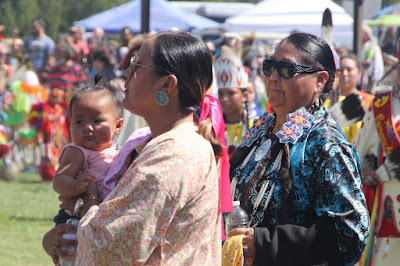Military veterans march on the colors for the opening ceremonies.
The red objects at either end are war lances being carried as guideons.
Jean wanted to visit a Native American Powwow, and had
found two the same weekend: one near Tahlequah, and another at Lawton, OK, near
Fort Sill. She decided to visit the
latter. We were going to make an early
morning drive in the darkness, and then spend the night near Fort Sill before
returning on Sunday. This was going to
be an unusual trip in many regards, like having a rare bobcat run across the
road in front of us shortly after starting out.
The guideons were war lances and used to show the unit
designation and military branch affiliation. The bead work on
the shaft represent campaign ribbons.
Living in Indian Territory is unique in many
regards. Until this weekend, we have
viewed all those unique differences as positive. We are of course surrounded by old tribal
nation reservations belonging to about any tribe you can name. Some of the reservations have been broken up
to the point that one would never guess they were on an ‘indian’ reservation,
and others have tenaciously clung to their reservation identity. In most, the native population think of us as
fellow Oklahomans, but in others, we are still invading white men and are
viewed with a racial bias no different than one would expect in a black
community in some areas of Chicago. Our
most favorite powwow visit was at the six Kaw nation’s powwow. These include the Kaw or Kanza, Ponca, Osage, Pawnee, Tonkawa,
and Otoe-Missouria tribes, who were originally the Winnebago. The event was held at the tribal grounds
named after Chief Standing Bear, just south of Ponca. Here we seemed to be viewed as any people
with a deep interest in understanding and appreciating their tribal heritage
and culture. We were extended a friendly
hand, a welcoming hand. Several families
nearly adopted us. One would invite us
to sit near them so they could explain each facet of the tribal regalia and the
imagery surrounding the various dances.
Another would suggest what we might have for dinner, where to find it,
and ask us to join them for dinner. Both
officially and personally, it was made clear frequently that we were both
welcome and expected to return. The
Comanche powwow, unfortunately, took us to the other end of the spectrum. It became clear that this was a closed event,
a family or tribal event. During the day
there were no fewer than thirty unfriendly references about whites and another twenty
or so about non-Comanches. A few people
were openly hostile and rude, while most were just unfriendly and aloof, unless
I had my wallet in my hand. That sounds
negative. Let’s just say we left with a
feeling of being very unwelcome.
The one thing the Comanche, and most other tribes, do a great job of
is carrying on their Native American cultures and traditions through all
ages of their community. The babies, also often decked out in their own
regalia, along with mother and grandmother, will all be seen participating
in every aspect of the powwow.
These boys have just completed registering for their
participation in various aspects of tribal dancing.
For the Comanche tribe, the powwow was a success and a
great draw. There were representatives
there from both North and South Dakota, North and South Carolina, Florida,
Minnesota, New York, and others who also traveled great distances to
attend. The two extremes were a
representative of the Athabaskans of Alaska, and in a cultural exchange, a
group of six from Siberia that had come just to attend the event. Some or all of those from Siberia were
professional singers. One sang a song in
his native tongue, and another that is noted as a ‘throat singer’ showed off
that skill. The only way I can describe
the sound of his deep-throat singing is to point to the sound of the Australian
aboriginal didgeridoo, only he did all of this without any instrument. If even that doesn’t paint a picture, take a
look at this, and you’ll see where I came up with the idea of the didgeridoo: https://www.youtube.com/watch?v=NaBI1SqIhak
Now here are a couple examples of the deep-throat
singing that sound very unusual to our Western ears.
Young men also shown after dance registration. One can't help
noticing the sense of pride clearly exhibited while in their native regalia.
























